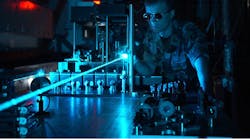Terahertz energy offers great promise for scientific and medical analysis, provided that signals above the millimeter-wave frequency range can be generated at sufficient power levels. Terahertz signals are typically generated by one of three different kinds of sources: optical or optoelectronic devices; solid-state oscillators; or vacuum electron devices, such as backward-wave oscillators (BWOs). So far, BWOs have shown the most capability for producing output-power levels as high as 10 W at frequencies to 300 GHz. Most of the terahertz sources produce considerably less output power and operate with extremely low efficiencies, so that the generation of usable terahertz power levels is often the starting point in the design of a research or medical terahertz system.
In pursuit of practical terahertz power, several French researchers from the Commissariat de l’Energie Atomique, Centre d’Etudes Scientifiques et Techniques d’Aquitaine, and the Centre d’Etudes Nucleaires de Bordeaux-Gradignan explored the design of a compact planar Smith-Purcell (SP) free-electron laser (FEL) with significant output power at millimeter-wave frequencies and in the low-frequency portion of the terahertz frequency range. The researchers performed simulations on an SP FEL employing a planar grating with 1-mm period.
The results of their studies revealed great potential for the planar approach versus earlier FELs using cylindrical gratings. Simulations of the planar SP FEL with beam energy of 60 keV and beam current of 2 to 5 A yielded estimated output power of about 200 W at 100 GHz for a 4-A beam, with about 0.08% efficiency. Although the planar approach tends to produce less energy at harmonic frequencies than the cylindrical designs, it is considerably simpler and can be made much smaller than cylindrical SP FELs.
See: “Radiation at 100 and 200 GHz From a Compact Planar Smith-Purcell Free Electron Laser,” IEEE Transactions on Terahertz Science and Technology, Vol. 7, No. 2, March 2017, p. 151.

